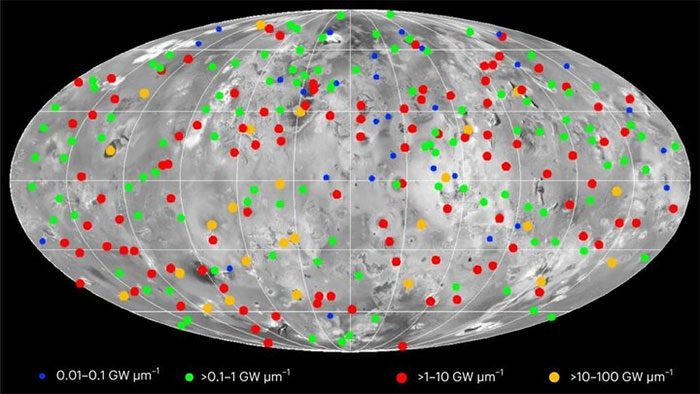The moon Io of Jupiter is covered with hundreds of active volcanoes, and now experts have created the first map simulating this phenomenon.
While many moons in the Solar System exhibit various bizarre and fascinating characteristics, few can compare to the extreme volcanic world of Io, Jupiter’s moon. It is a chaotic world with the most intense volcanic activity in the Solar System.
Io is the innermost of Jupiter’s four largest moons. Slightly larger than Earth’s Moon, it boasts the strongest volcanic activity in the Solar System, erupting plumes that reach over 500 km into the sky.
As the closest moon to the giant planet, Io is subjected to powerful gravitational forces as it orbits Jupiter. Its mineral composition is constantly pulled and pushed by these gravitational forces, generating frictional heat deep within the moon, which results in its extremely vigorous volcanic activity.
The volcanic activity occurring across Io could shed light on many mysterious mechanisms within. Due to the poor data regarding the poles of this celestial body, scientists have so far lacked a comprehensive map describing its volcanic activity, making it difficult to deduce the underlying causes.

Io is covered by hundreds of volcanoes. This is the world with the most intense volcanic activity in the Solar System. (Photo: Nature Astronomy/Creative Commons Attribution 4.0).
In a new study, experts analyzed data from NASA’s Juno spacecraft, which orbits Jupiter. Juno also flew past Io, collecting near-infrared scans at the poles of Io, providing a clear view of the entire activity on this moon.
The lead author of the new work, Ashley Davies, a volcanologist at NASA’s Jet Propulsion Laboratory at the California Institute of Technology, stated: “This is a significant advance in our understanding of the complex volcanic activity on Io.”
The team discovered 266 active volcanic hotspots on Io, all illustrated on the latest map. The number of volcanoes scattered across the polar regions is comparable to other areas on the moon, but the volcanoes in the polar regions emit less than half the energy of those in other regions.
They also found that the volcanoes in Io’s northern pole have twice the energy output compared to those in the southern pole. The reason for this is still unclear, but it may be that the geological crust in the southern pole is thicker than that in the northern pole, making it harder for magma to rise to the surface and erupt.
Additionally, based on computer models simulating Jupiter’s moon, experts suggest that Io may have a massive subsurface ocean of magma beneath its surface.


















































